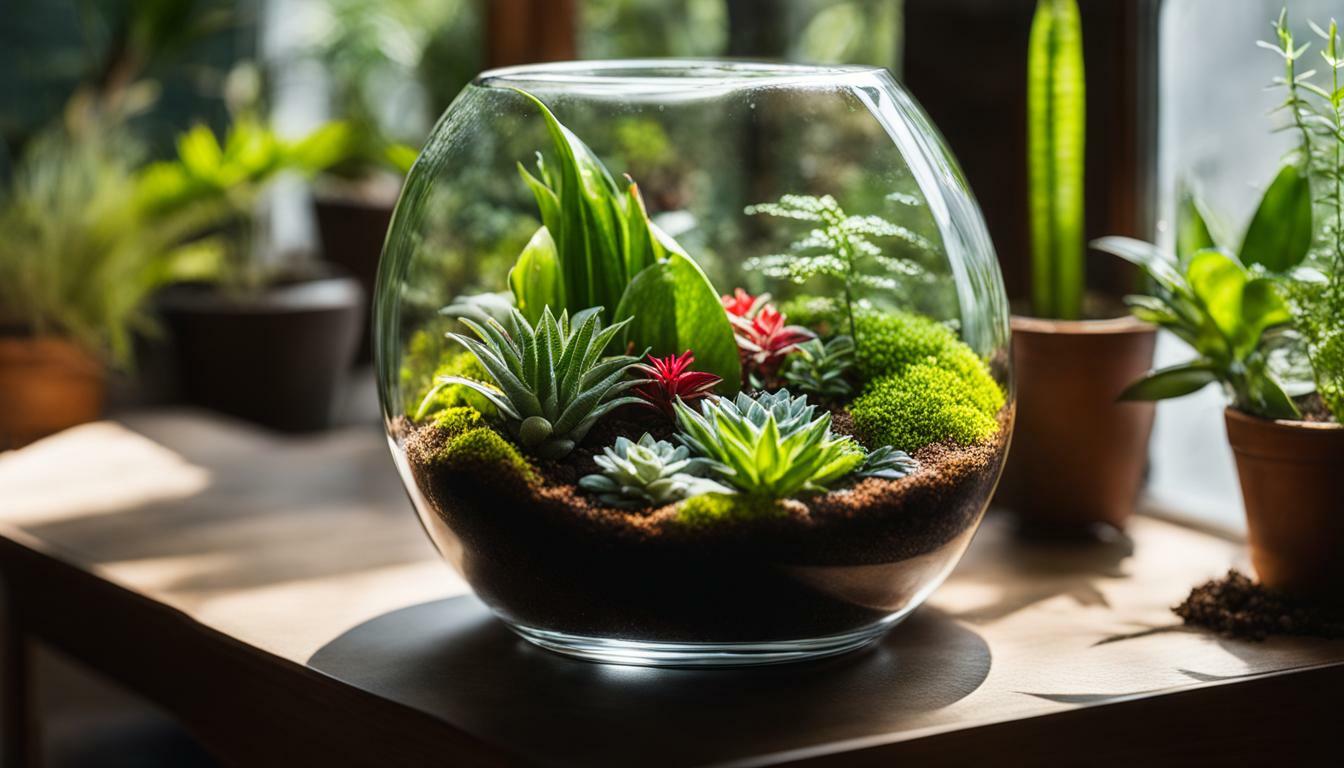Terrarium plants offer a wonderful opportunity for beginners to bring the beauty of nature indoors with minimal effort. These low-maintenance plants require very little care, making them perfect for those new to indoor gardening. When selecting plants for your terrarium, it’s essential to consider factors like the plant’s natural habitat and growth rate. By understanding these aspects, you can create an ideal environment for your chosen plants to thrive.
Key Takeaways:
- Terrarium plants are low-maintenance and require minimal care, making them ideal for beginners.
- Consider the natural habitat and growth rate of plants when selecting them for your terrarium.
- Tropical plants that thrive in high humidity and low to medium lighting are suitable for terrariums.
- Small terrarium plant options include mosses, air plants, and baby tears.
- Medium-sized terrarium plants can include nerve plants, spiderwort, and polka dot plants.
Terrarium plants offer a unique and low-maintenance way to bring a piece of nature indoors. With their ability to thrive with minimal care, these plants are perfect for beginners. Whether you choose small, medium-sized, or larger plants for your terrarium, there are options to suit every preference and space. By understanding the natural habitat of your chosen plants and providing the right conditions, you can create a beautiful and thriving indoor garden.
Why Terrarium Plants are Ideal for Beginners
Terrarium plants are the perfect option for beginners as they require very little maintenance and still provide the benefits of indoor greenery. Whether you have a busy lifestyle or lack a green thumb, terrarium plants offer a low-maintenance way to introduce plants into your home or office space.
One of the key reasons why terrarium plants are ideal for beginners is their ability to thrive with minimal care. These plants are typically low maintenance and can tolerate a range of conditions, making them forgiving for those who may forget to water or fertilize regularly. Unlike traditional houseplants that require constant attention, terrarium plants can be enjoyed without the stress of constant upkeep.
Adding a touch of greenery to your environment is known to have numerous benefits, including improved air quality and reduced stress levels. Terrarium plants offer an effortless way to bring a piece of nature indoors, transforming any space into a calming oasis. With their compact size and aesthetic appeal, these plants can fit in various areas, from small desks to large living rooms, making them versatile for beginners seeking to enhance their surroundings.
To get started with terrarium plants, it’s important to choose the right ones for your indoor garden. Consider the natural habitat and growth rate of the plants you select. Tropical plants that thrive in high humidity and low to medium lighting conditions are generally well-suited for terrariums. Some popular options for small terrariums include mosses, air plants, and baby tears, while medium-sized terrariums can accommodate nerve plants, spiderwort, and polka dot plants. For larger terrariums, maidenhair ferns, peace lilies, and snake plants are excellent choices.
Benefits of Terrarium Plants for Beginners:
- Require minimal maintenance and are forgiving for forgetful caretakers.
- Add a touch of greenery and improve air quality.
- Fit in various spaces and enhance the overall aesthetics of the environment.
- Offer a wide range of plant options based on size and lighting requirements.
With their low-maintenance nature and ability to bring a piece of nature indoors, terrarium plants are the perfect choice for beginners looking to enjoy the benefits of indoor greenery without the added stress of demanding care routines. Start your journey with terrarium plants today and watch them thrive in their controlled environment.
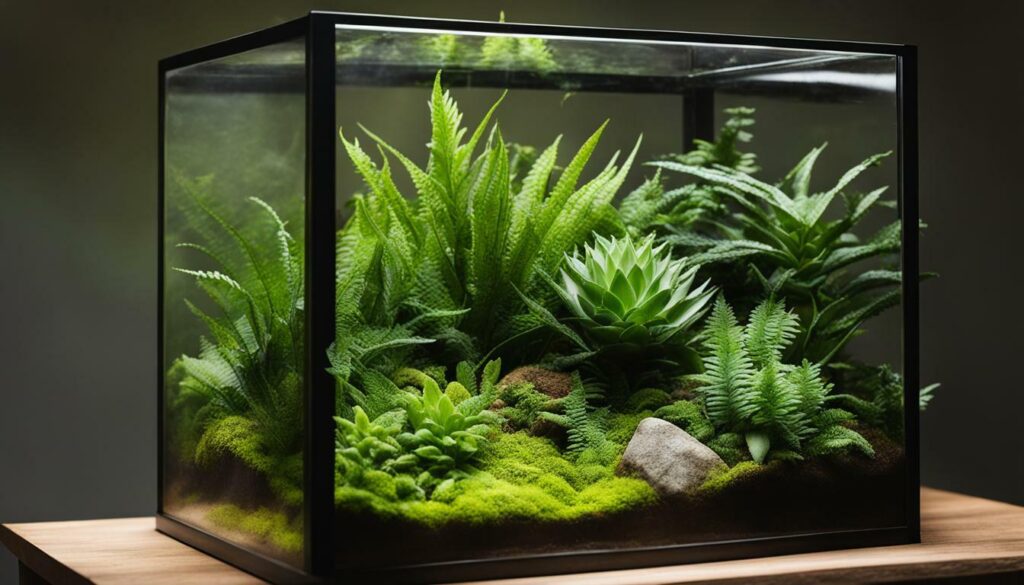
To ensure the health and well-being of your terrarium plants, it’s essential to consider their natural habitat and the specific conditions they require. Terrarium plants, just like any other living organisms, have evolved to thrive in particular environments, and replicating those conditions within your terrarium will lead to successful plant growth.
Tropical plants, for example, are well-suited for terrariums due to their ability to thrive in high humidity and low to medium lighting. These plants are accustomed to the warm, moist conditions found in their natural habitats, such as rainforests. By recreating these conditions, you can provide your terrarium plants with an environment that closely resembles their native homes.
When selecting terrarium plants, it’s important to choose species that have similar growth rates. This will help ensure that one plant does not overtake the others and create an imbalanced ecosystem within your terrarium. It’s also crucial to consider the eventual size of the plants, as overcrowding can inhibit growth and lead to competition for resources.
The specific conditions required for terrarium plants may vary depending on the species. Here are a few examples:
| Terrarium Plant | Natural Habitat | Growth Rate |
|---|---|---|
| Mosses | Shaded, damp forest floors | Slow |
| Air Plants | Tropical rainforests | Slow to moderate |
| Baby Tears | Moist, humid environments | Fast |
By carefully considering the natural habitat and growth rate of terrarium plants, you can create a thriving mini-ecosystem that brings the beauty of nature into your indoor space. Remember to research each plant’s specific requirements, provide adequate lighting, and maintain the appropriate humidity levels to ensure the long-term health of your terrarium plants.
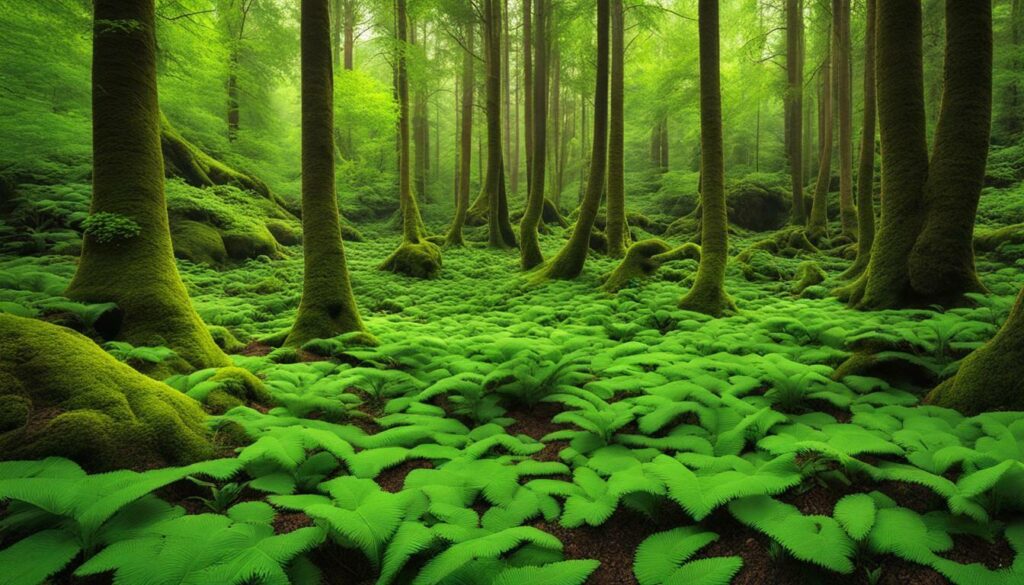
Terrarium plants offer a unique and low-maintenance way to incorporate greenery into your home or office. With a little knowledge about their natural habitat and specific conditions, you can create a beautiful and self-sustaining environment that brings the wonders of nature indoors.
Small Terrarium Plant Options
When it comes to choosing plants for your small terrarium, options like mosses, air plants, and baby tears can be excellent choices due to their compact size and low maintenance needs. These plants not only add a touch of greenery to your indoor space but also thrive well in the unique conditions of a terrarium.
Mosses are a popular choice for small terrariums due to their ability to grow in low light conditions and retain moisture. They create a lush and natural look, adding a sense of tranquility to any terrarium. Additionally, they help to regulate humidity levels and prevent excess moisture buildup.
Air plants, also known as Tillandsias, are another great option for small terrariums. These unique plants don’t require soil to grow as they absorb moisture and nutrients from the air. They can be attached to various surfaces like rocks or driftwood, adding an interesting element to the terrarium. Air plants are low maintenance and can tolerate a wide range of lighting conditions.
Baby tears, scientifically known as Soleirolia soleirolii, are delicate and attractive plants that are commonly used in terrariums. Their tiny leaves form a dense mat-like carpet, giving a lush and visually appealing look to the terrarium. Baby tears thrive in high humidity and moderate lighting conditions, making them a suitable choice for small terrariums.
| Plant | Characteristics | Care Requirements |
|---|---|---|
| Mosses | Lush, compact growth | Low light, high humidity |
| Air plants | No soil required | Wide range of lighting conditions |
| Baby tears | Dense carpet-like growth | High humidity, moderate lighting |
These small terrarium plants are not only aesthetically pleasing but also require minimal effort to maintain. They offer a great opportunity for beginners to introduce greenery into their homes or workspaces while enjoying the benefits of indoor gardening. So, go ahead and create your own mini ecosystem with these charming plants.
Remember, terrariums are self-contained environments, so it’s important to select plants that can thrive in these conditions. By choosing small terrarium plant options like mosses, air plants, and baby tears, you ensure that your terrarium remains healthy and vibrant without requiring constant attention or care.
Why choose small terrarium plants?
- Compact size makes them ideal for small terrariums.
- Low maintenance requirements suit beginners with limited gardening experience.
- Provide a lush and natural look to your terrarium.
- Help regulate humidity levels in the enclosed environment.
- Add a touch of greenery and tranquility to your indoor space.
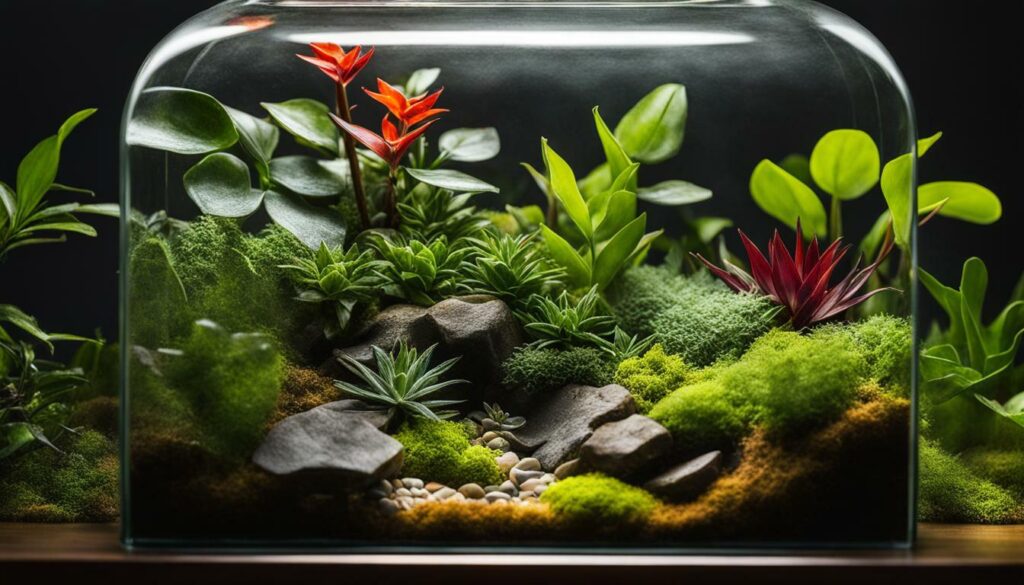
Medium-sized Terrarium Plant Options
If you have a medium-sized terrarium, considering plants like nerve plants, spiderwort, and polka dot plants can create a visually pleasing and vibrant display. These plants offer a range of colors, textures, and shapes that can transform your terrarium into a miniature jungle.
Nerve plants, also known as Fittonia, are popular choices for medium-sized terrariums due to their attractive foliage. These plants feature intricate patterns of veins in vibrant shades of red, pink, or green, adding a striking visual element to your terrarium. Nerve plants thrive in humid environments and prefer indirect sunlight, making them perfect for terrariums placed in bright but shaded areas.
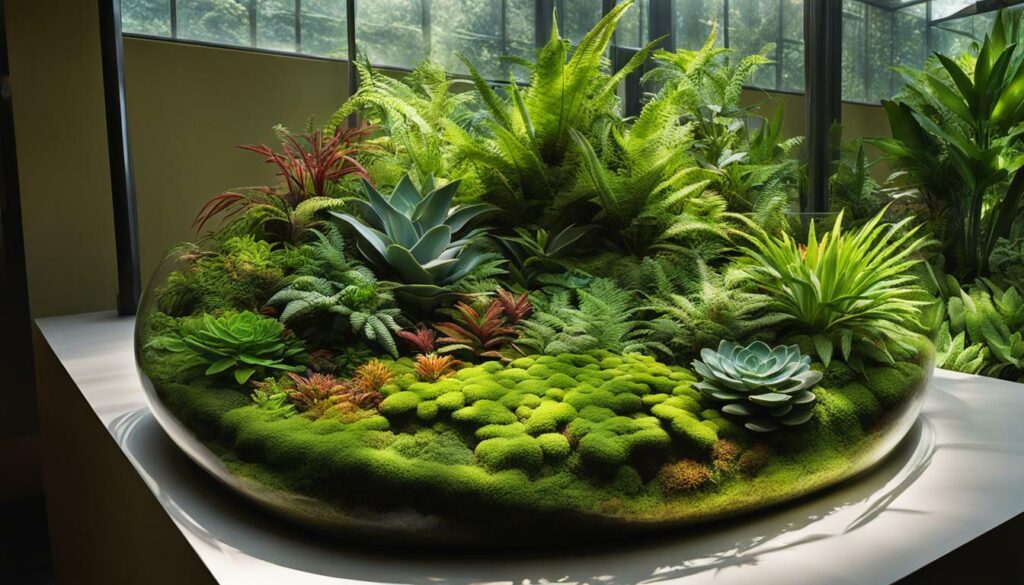
Spiderwort plants (Tradescantia) are another fantastic option to consider. Their long, trailing stems with clusters of small, colorful flowers create a cascading effect that adds depth and dimension to your terrarium. Spiderwort plants adapt well to different lighting conditions, making them versatile choices for medium-sized terrariums.
Polka dot plants (Hypoestes phyllostachya) are prized for their vibrant foliage, which is covered in speckles or splotches of contrasting colors. This unique pattern gives the plant its name and makes it a captivating addition to any terrarium. Polka dot plants prefer bright, indirect light and thrive in humid environments, making them ideal for terrariums.
Suitable Plants for Larger Terrariums
Larger terrariums offer the opportunity to showcase striking plants like maidenhair ferns, peace lilies, and snake plants, creating a captivating indoor green oasis. These plants, known for their lush foliage and unique characteristics, can truly transform your terrarium into a stunning centerpiece. Let’s take a closer look at each of these plants and what makes them ideal for larger terrariums.
| Plant | Growth Habit | Care Requirements |
|---|---|---|
| Maidenhair Ferns | Delicate, lacy fronds | Requires high humidity, indirect light, and well-draining soil |
| Peace Lilies | Glossy, dark green leaves and elegant white flowers | Thrives in moderate to bright indirect light, prefers moist soil |
| Snake Plants | Tall, robust leaves with variegated patterns | Tolerates a wide range of lighting conditions, prefers well-draining soil |
Maidenhair ferns are known for their delicate and lacy fronds, adding an elegant touch to any terrarium. These ferns thrive in high humidity and prefer indirect light, making them a perfect fit for larger terrariums. Peace lilies, with their glossy dark green leaves and stunning white flowers, bring a sense of tranquility to your indoor garden. They prefer moderate to bright indirect light and thrive in moist soil, making them an excellent addition to larger terrariums. Snake plants, also known as mother-in-law’s tongue, boast tall and robust leaves with unique variegated patterns. They can tolerate a wide range of lighting conditions and require well-draining soil, making them a versatile choice for larger terrariums.
Bringing Nature Indoors
As you select plants for your larger terrarium, consider the unique features and care requirements of each species. Creating a green oasis in your living space not only adds beauty but also provides a connection to nature. Larger terrariums allow for more creative freedom, enabling you to experiment with various plant combinations and designs. Remember to maintain optimal moisture levels by watering sparingly and using a spray bottle to ensure the plants thrive in their controlled environment. The captivating appeal of maidenhair ferns, peace lilies, and snake plants will undoubtedly leave a lasting impression on both you and your guests.
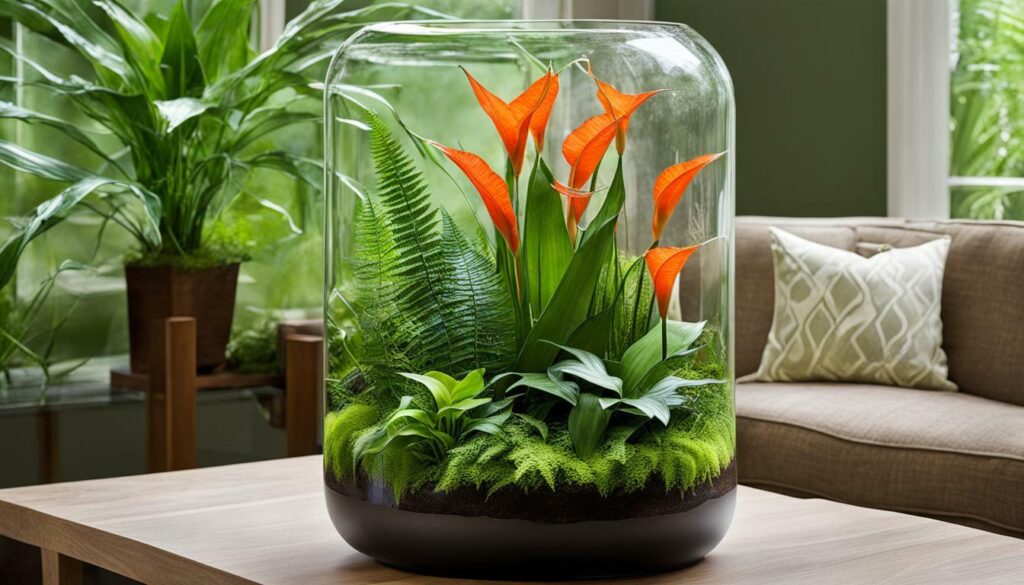
In summary, larger terrariums offer the opportunity to showcase striking plants such as maidenhair ferns, peace lilies, and snake plants. The combination of their lush foliage, unique growth habits, and low-maintenance care requirements make them perfect choices for larger indoor green spaces. Whether you’re aiming to create a serene natural retreat or simply brighten up your home, these plants will bring beauty and vibrancy to your terrarium, turning it into a captivating oasis.
Watering Tips for Terrarium Plants
Proper watering is crucial for the health and longevity of your terrarium plants, especially when it comes to closed terrariums. The enclosed environment of a closed terrarium creates a self-sustaining ecosystem where the plants recycle moisture. Here are some essential watering tips to ensure your terrarium plants thrive:
- Water sparingly: Unlike traditional houseplants, terrarium plants require minimal watering due to the closed environment. Overwatering can lead to root rot and fungi growth. Avoid waterlogged soil by allowing the top layer to dry out before watering again.
- Use a spray bottle: A spray bottle is the best tool for watering terrarium plants. Mist the plants with a fine mist, aiming for the leaves rather than the soil. This helps maintain the optimal humidity levels within the terrarium while preventing excessive moisture buildup.
- Observe plant needs: Different terrarium plants have varying water requirements. While some plants prefer slightly drier conditions, others thrive in more moisture. Take note of the specific needs of your plant selections and adjust watering accordingly.
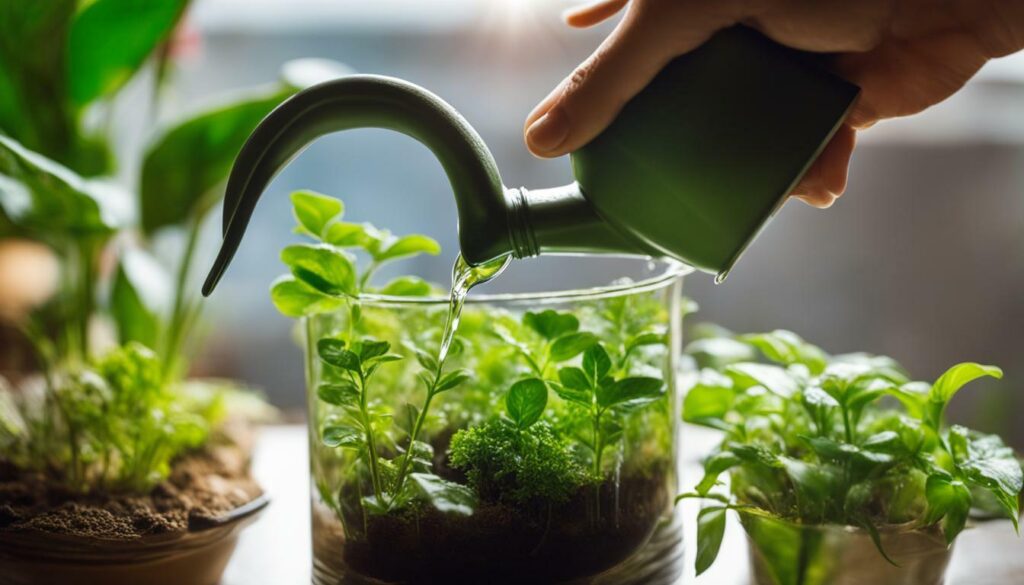
Remember, it’s better to underwater than overwater your terrarium plants. A dry period allows the roots to breathe and helps prevent water-related issues. Monitoring the moisture levels and adjusting watering frequency accordingly will help maintain a healthy and vibrant terrarium ecosystem.
In addition to proper watering, it’s important to ensure adequate drainage within your terrarium. A layer of activated charcoal or gravel at the bottom of the container helps prevent water from pooling and causing root rot. Regularly inspect your terrarium to ensure there are no signs of excessive moisture or pests.
By following these watering tips, you can enjoy a thriving terrarium filled with lush, low-maintenance plants. Create your own miniature indoor oasis and bring a touch of nature into your home with the beauty of terrarium plants.
The Unique Appeal of Terrarium Plants
Terrarium plants offer a unique and low-maintenance way to bring a touch of nature into your indoor spaces, providing a delightful sight that is both relaxing and rewarding. These miniature gardens encapsulate the beauty and serenity of an outdoor environment within the confines of a glass enclosure. With their lush green foliage and intricate details, terrarium plants create a captivating display that adds a sense of tranquility to any room.
One of the key advantages of terrarium plants is their low-maintenance nature. Unlike traditional houseplants, terrarium plants thrive with minimal care, making them an ideal choice for beginners or those with busy lifestyles. These plants require less watering and pruning compared to their larger counterparts, allowing you to enjoy their beauty without the hassle of constant maintenance.
Furthermore, terrarium plants provide a connection to the natural world, even in urban settings. The presence of greenery indoors has been proven to have a positive impact on our well-being, reducing stress and improving air quality. Terrariums create a mini ecosystem that brings the beauty of nature into your living space, providing a refreshing and rejuvenating atmosphere.
Whether you choose small, medium-sized, or large terrarium plants, you can create a personalized indoor garden that suits your style and space. From the delicate beauty of mosses and air plants to the vibrant foliage of peace lilies and snake plants, there is a wide variety of options to choose from. Each plant brings its own unique charm, allowing you to create a visually stunning and captivating terrarium display.
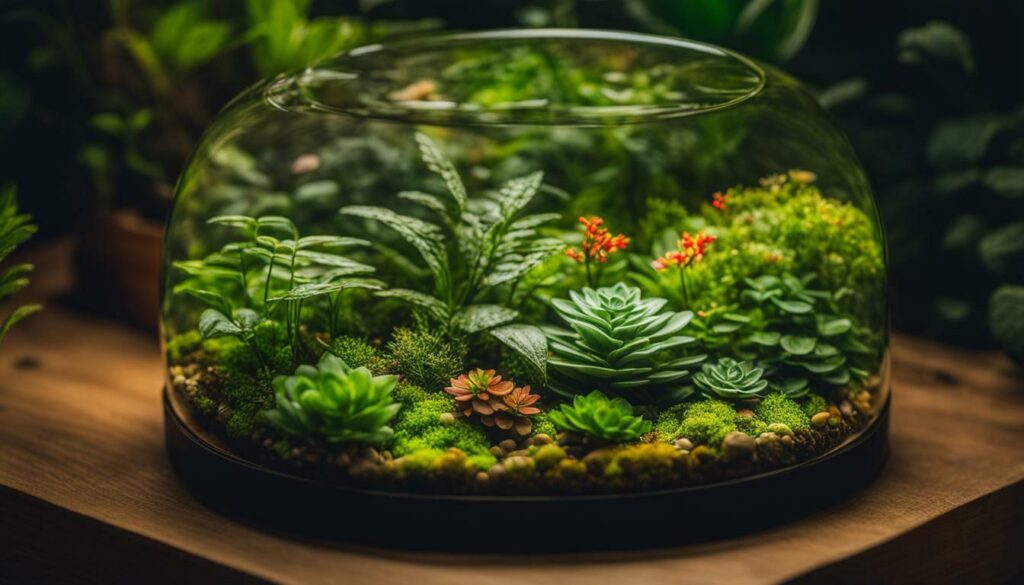
“Terrarium plants provide a unique and low-maintenance way to bring a little piece of nature indoors.”
| Terrarium Plants | Size | Growth Habits | Care Requirements |
|---|---|---|---|
| Mosses | Small | Low-growing and compact | Requires high humidity and low light |
| Air Plants | Small | Epiphytic and can grow without soil | Requires misting or soaking to provide moisture |
| Baby Tears | Small | Trailing and delicate foliage | Requires consistent moisture and indirect light |
Terrarium plants offer a multitude of options for creating your own indoor oasis. Their low-maintenance nature and the wide range of plant choices make them an excellent addition to any home or office space. With their unique appeal and easy care requirements, terrarium plants bring the beauty of nature right to your fingertips.
Conclusion
By selecting the appropriate terrarium plants, you can create a thriving and visually appealing indoor garden while enjoying the ease of their care. Terrarium plants are a great option for beginners due to their low-maintenance nature. When choosing plants for your terrarium, it’s important to consider their natural habitat and growth rate. Tropical plants that thrive in high humidity and low to medium lighting conditions are ideal choices.
For small terrariums, mosses, air plants, and baby tears are suitable options. These plants add a touch of greenery and require minimal care. If you have slightly larger enclosures, medium-sized terrarium plants like nerve plants, spiderwort, and polka dot plants can provide aesthetic appeal.
For larger terrariums, consider plants like maidenhair ferns, peace lilies, and snake plants. These plants have the ability to fill larger spaces while maintaining their lush appearance.
When it comes to watering, it’s crucial to water terrarium plants sparingly, especially in closed terrariums. Using a spray bottle to mist the plants can help maintain optimal moisture levels without overcrowding the terrarium environment.
In conclusion, terrarium plants offer a unique and low-maintenance way to bring a little piece of nature indoors. With the right selection of plants, you can create a beautiful and thriving indoor garden that requires minimal effort to maintain. So go ahead, choose the perfect terrarium plants and enjoy the beauty of nature in your own home.
FAQ
Why are terrarium plants a great option for beginners?
Terrarium plants require very little maintenance, making them ideal for beginners who may not have much experience with indoor gardening.
What factors should I consider when choosing plants for a terrarium?
When selecting plants for a terrarium, it’s important to consider their natural habitat and growth rate. Plants that thrive in high humidity and low to medium lighting are ideal for terrariums.
What are some small terrarium plant options?
Some small terrarium plant options include mosses, air plants, and baby tears. These plants are well-suited for smaller enclosures and require minimal care.
What are some medium-sized terrarium plant options?
Medium-sized terrarium plant options include nerve plants, spiderwort, and polka dot plants. These plants are suitable for slightly larger enclosures and offer aesthetic appeal.
What are some suitable plants for larger terrariums?
Some suitable plants for larger terrariums include maidenhair ferns, peace lilies, and snake plants. These plants can fill larger spaces while maintaining their lush appearance.
How should I water my terrarium plants?
It’s important to water sparingly in a closed terrarium. Spraying the plants with a spray bottle is recommended to maintain optimal moisture levels without overcrowding the terrarium environment.
What is the unique appeal of terrarium plants?
Terrarium plants provide a unique and low-maintenance way to bring a little piece of nature indoors. They require less time and effort compared to traditional houseplants and can add a touch of greenery to any space.

